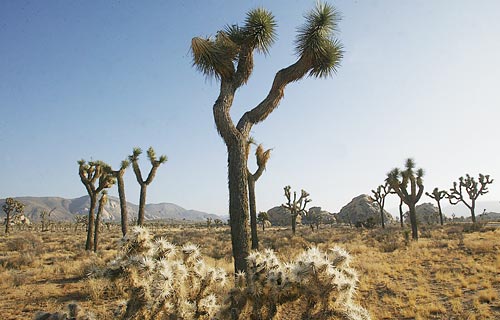
'Corridors' of power are finding resistance
 |
| If the Energy Department
is allowed to proceed with its grid project,
some of the transmission lines stand a chance
of being routed through Joshua Tree National
Park. Such prospects have drawn lawsuits from
environmental groups. Hal Wells / Los Angeles
Times |
Mar 24, 2008 - Judy Pasternak -
Los Angeles Times
The nation's electric grid needs beefing up, but
critics say a federal plan is too big and ignores
clean energy sources.
WASHINGTON -- There is wide agreement that the nation
needs to upgrade the aging system that delivers electricity
from power plants to consumers -- a grid that is already
overtaxed and facing a 43% increase in demand over
the next two decades.
But opposition is growing to the way the Bush administration
has interpreted Congress' instructions to improve
the grid.
The Energy Department is making it easier to build
high-voltage transmission lines in vast stretches
of the country, but objections have been raised by
environmentalists, lawmakers and states that would
lose the right to veto power lines within their borders.
The 2005 Energy Policy Act gave the Energy Department
the right to designate "national interest electric
transmission corridors" where the federal government
can step in to permit transmission towers and wires
that have been rejected or delayed by states. In the
corridors, the U.S. can also condemn private land
along a power line route.
Now the department has set up two corridors that
are actually huge swaths of territory. The western
zone includes Southern California and western Arizona.
The eastern zone cuts from New York to Virginia and
inland across large sections of Pennsylvania, West
Virginia and Ohio.
Transmission of electricity is critically congested
at the core of each zone, the Energy Department said.
The federal authority in the corridors is already
attracting interest from utilities, including Southern
California Edison.
But critics say that the zones are too large and
were drawn to favor power from plants that run on
fossil fuels rather than cleaner sources such as wind,
solar and heat from the Earth's interior, which also
will need transmission if they are to be part of the
country's energy mix. The chosen contours of this
plan, they say, will exacerbate global warming and
pollution.
They have also cited the potential effects on farmland
and natural habitats. The National Trust for Historic
Preservation has listed the eastern zone as one of
its "11 most endangered places" because of Civil War
battlefields, stretches of the Appalachian Trail,
designated historic districts and scenic rivers that
could fall within power line paths.
But administration officials like to compare their
initiatives to President Eisenhower's creation of
the interstate highway system, and they say it will
help keep energy prices down.
"The grid is the ultimate balancing act. The larger
the grid is, the easier it is to balance," said Kevin
Kolevar, an assistant secretary of Energy who directs
the 3-year-old Office of Electricity Delivery and
Reliability.
More than 157,000 miles of high-voltage wires in
the U.S. shoot electricity to areas where the energy
is needed. But the electrical grid as currently constituted
is really four separate regional sets of wires, with
few connections between them.
Additions to this infrastructure have been slow,
with only 668 miles of interstate transmission built
since 2000. Each state makes a separate decision on
its part of the route.
Kolevar said the new zones were large to allow for
flexibility in determining the sites for the lines,
so that sensitive areas could be avoided. As for fossil
fuels versus alternatives, the department is "generation-neutral.
We really are," he said.
The crux of the problem lies with proposals for
power lines that cross state borders, Kolevar said.
States, he said, "can't take a confederate point of
view and not consider the needs of their neighbors."
There is one escape hatch for states in the corridors,
he said. When three or more states form a compact
for transmission planning, the federal government
will cede its authority to that regional group. "We
need to see these states coming together, binding
themselves to one another," he said.
Like others backing the federal zones, Kolevar cited
a line running through Virginia and West Virginia
that took 16 years to get approved. The national interest
corridors are "a backstop" to speed up development,
he said.
Southern California Edison was the first to look
into taking advantage of the new backstop authority.
Company representatives met with federal regulators
last month about a 500,000-volt line it wants to build
between the Palm Springs area and power plants near
Phoenix that generate electricity using natural gas.
Both ends of the line are in the Southwest Energy
Corridor unveiled by the Energy Department in October.
California has approved the portion of the line within
its borders, but Arizona's utility commissioners vetoed
their part of the project last May because California
hadn't built any new power plants of its own for decades.
One Arizona commissioner referred to the proposed
line as "a 230-mile extension cord into Arizona."
Another said, "I don't want Arizona to become an energy
farm for California," adding that his state would
get all of the pollution and none of the power.
Southern California Edison is exploring an appeal
to the Federal Energy Regulatory Commission. Commission
officials said their approval would not be automatic,
and they would consult with the states.

|